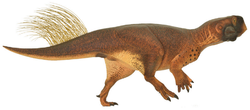| Beg tse Temporal range: Early Cretaceous ~ | |
|---|---|
 | |
| Holotype skull | |
| Scientific classification | |
| Domain: | Eukaryota |
| Kingdom: | Animalia |
| Phylum: | Chordata |
| Clade: | Dinosauria |
| Clade: | † Ornithischia |
| Clade: | † Ceratopsia |
| Clade: | † Neoceratopsia |
| Genus: | † Beg Yu et al., 2020 |
| Species: | †B. tse |
| Binomial name | |
| †Beg tse Yu et al., 2020 | |
Beg tse (after the Himalayan war deity Beg-tse) is an extinct species of neoceratopsian dinosaurs from the early Cretaceous Ulaanoosh Formation of Mongolia. B. tse is the only species in the genus Beg, known from a partial skull and very fragmentary postcrania. It represents the most basal neoceratopsian currently known.




